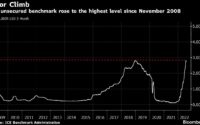Fed closing in on end of rate hiking cycle, central bank officials say
By Ann Saphir and Michael S. Derby
(Reuters) -The Federal Reserve will likely need to raise interest rates further to bring down inflation that is still too high, but the end to its current monetary policy tightening cycle is getting close, several U.S. central bank officials said on Monday.
The Fed has raised interest rates by 5 percentage points since March 2022 to bring down the highest U.S. inflation in four decades. Fed policymakers opted last month to forego a rate increase to give themselves time to assess the still-developing effects of the previous hikes in borrowing costs, even as most also penciled in at least two more increases by the end of 2023.
“We’re likely to need a couple more rate hikes over the course of this year to really bring inflation” sustainably back to the U.S. central bank’s 2% goal, San Francisco Fed President Mary Daly said during an event at the Brookings Institution, giving voice to the most common view among her rate-setting peers at the Fed.
But, Daly added, while the risks of doing too little are still greater than those of overdoing it on rate hikes, the two sides are getting into better balance as the Fed nears “the last part” of its hiking cycle.
Daly said she fully supported June’s policy decision, along with a go-slower approach that allows for more “extreme” data-dependence. “We may end up doing less because we need to do less; we may end up doing just that; we could end up doing more. The data will tell us.”
Fed policymakers are widely expected to deliver a rate hike at their meeting later this month, a move that would bring the policy rate to the 5.25%-5.50% range.
What’s less clear is whether they will raise rates again at the September meeting, wait until November, or just stay on hold and let inflation ease over time.
Fed Chair Jerome Powell has said he cannot rule out consecutive rate hikes to deal with stubbornly high inflation, which by the central bank’s preferred gauge, the personal consumption expenditures index, has fallen from a peak of 7% last year to 3.8% in May, still nearly twice the Fed’s target.
“We still have a bit of work to do,” Fed Vice Chair for Supervision Michael Barr said on Monday at a separate event. “I’ll just say for myself, I think we’re close.”
NEAR-TERM INFLATION EXPECTATIONS FALL
A survey released on Monday by the New York Fed on the state of consumer expectations in June showed near-term inflation expectations dropped to their lowest level since April 2021. That could buttress the case that price pressures are weakening, which in turn could take some pressure off the central bank to hike rates again. But the survey also showed a fifth straight month of expected home price gains, suggesting that housing inflation could again become an issue for the Fed at some point.
Atlanta Fed President Raphael Bostic, speaking at yet another event on Monday, repeated his view that the Fed can be “patient” on rates and allow restrictive policy to bring down inflation without further action by the central bank.
But within the Fed there remains a camp that feels just the opposite.
Commenting on last month’s policy meeting, Cleveland Fed President Loretta Mester told reporters, “if it was just me alone, I would have moved the rates up, but I understood the rationale for not moving in June,” given the importance of matching market expectations.
Mester, who does not have a vote on the Fed’s policy-setting committee this year, reaffirmed her view that interest rates will need to rise but was not yet ready to say that should happen at the July 25-26 meeting, as more data on the economy is inbound. Mester also said her outlook for rates is in line with or slightly above the Fed consensus of half a percentage point more of additional tightening before the end of the year.
Mester, however, said higher rates will be needed because “the economy has shown more underlying strength than anticipated earlier this year, and inflation has remained stubbornly high, with progress on core inflation stalling.”
(With reporting by Dan Burns and Howard Schneider; Editing by Paul Simao)
[ad_2]
Source link


